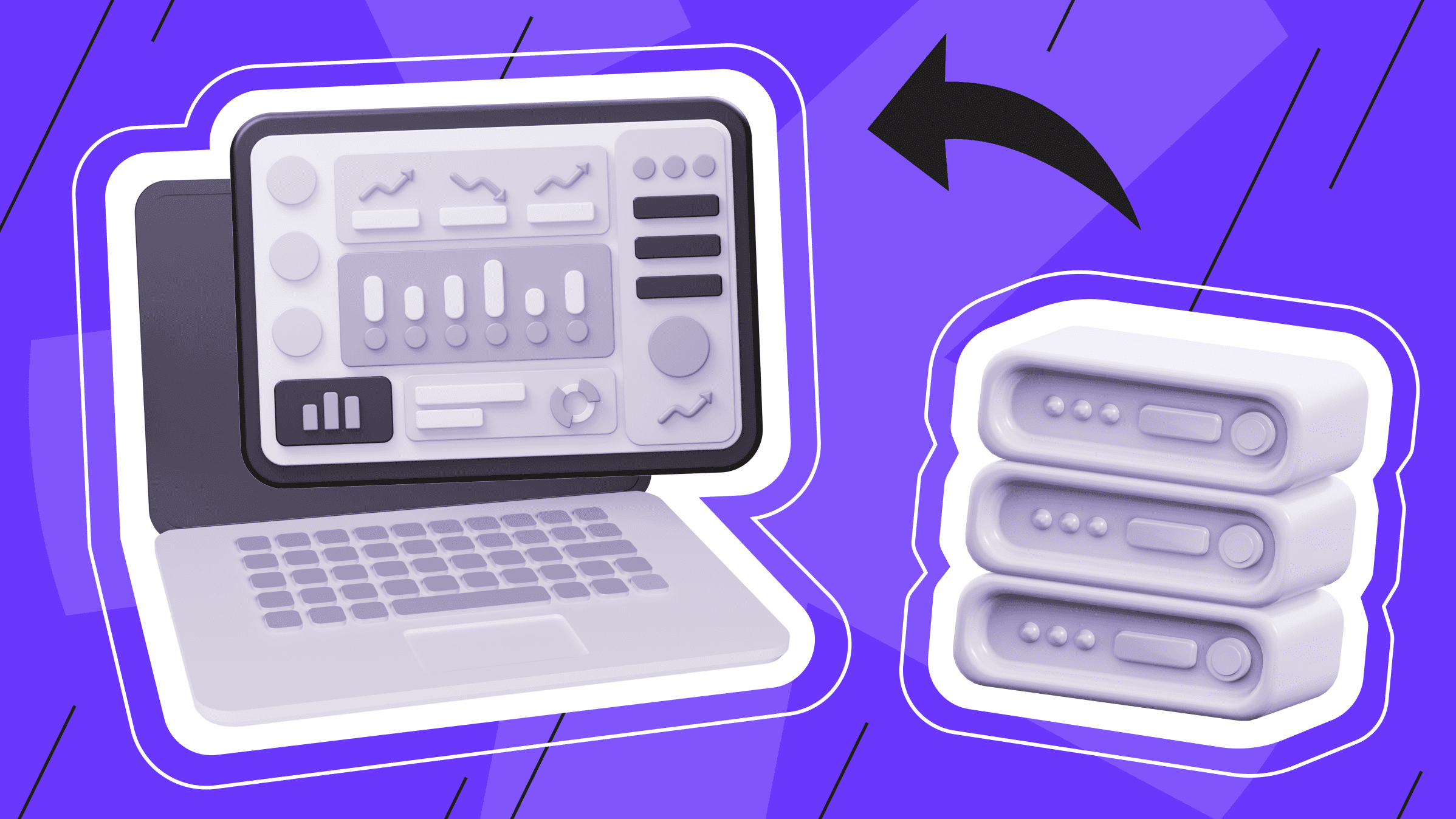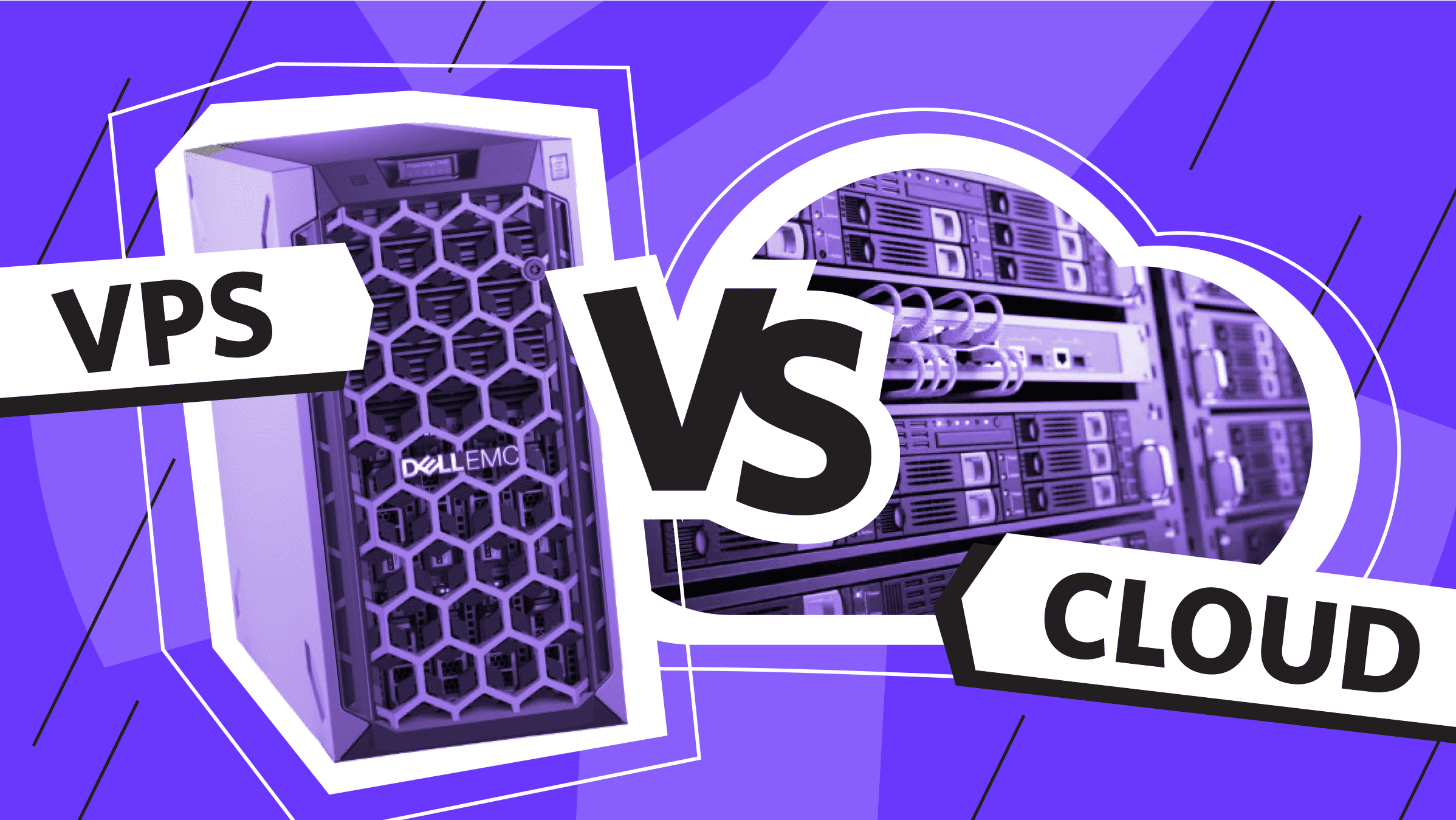
Server performance monitoring is a critical part of maintaining an efficient and reliable infrastructure. You'll get a behind-the-scenes view of your systems' performance by tracking key CPU, memory, disk, and network utilization metrics on your servers over time.
With this information, you can troubleshoot problems before they impact users, optimize resources, and provide technical support.
Why is Server Performance Monitoring Critical?
Server performance monitoring is part of the ongoing server management process and is critical to ensuring optimal performance of your servers and the projects hosted on them. This type of monitoring involves tracking, measuring, and analyzing various metrics to identify potential problems, optimize resource utilization, and prevent downtime.
Here are some of the main reasons why server performance monitoring is essential in hosting administration:
- Proactive problem detection. Continuous monitoring of server operation allows you to detect potential problems before they affect the work of users of this server or projects.
- Optimization of used resources. Performance monitoring helps identify bottlenecks and underutilized resources. With this information, you can optimize resource allocation to ensure that servers run efficiently and projects meet their needs.
- Hardware capacity planning. Monitoring data can help you predict future capacity needs. You can plan server upgrades or infrastructure expansions to accommodate growth and avoid unexpected outages by analyzing time trends and current hosting usage patterns.
- Guaranteed security. By tracking key security indicators, such as unauthorized access attempts or suspicious activity, you can respond quickly to potential threats.
- Cost savings. By monitoring server performance, you can avoid costly downtime and data loss. For example, using a VPS for small business can reduce some server resources to lower costs.
- Determines the root cause of problems. When problems occur, server performance monitoring data helps you quickly identify the root cause. This allows you to implement practical solutions and prevent similar issues in the future.
VPS
Virtual private servers - efficient operation at a favorable price. Fast NVMe, more than 30 countries, managed and unmanaged VPS.
By monitoring key metrics (CPU usage, memory usage, disk I/O, network traffic, application response time, uptime and downtime, and error logs) and analyzing the collected data, you can gain valuable insight into your servers' health and performance.
Key Server Performance Monitoring Metrics

These server metrics provide valuable information about how server performance is measured. This list is not exhaustive, but it includes basic metrics worth monitoring on an ongoing basis.
Optimizing CPU efficiency
CPU utilization measures the percentage of CPU resources used by the server. High CPU utilization can indicate resource shortages or performance weaknesses. Consistently running the CPU at or near 100% means that it is time to upgrade the CPU or add additional servers to spread the load.
Monitoring memory usage
The server constantly running low on memory may cause performance issues or system crashes. To resolve this, you can either increase the amount of RAM installed on the server or optimize memory usage by reducing the number of running applications or services.
Disk I/O and storage devices
Disk I/O monitors read and write operations on storage devices. High disk I/O levels may indicate poor storage performance or other issues. If disk I/O levels are high on a server, consider upgrading storage devices or optimizing disk usage by reducing the number of simultaneous I/O operations.
Analyzing network traffic and patterns
Network traffic measures the amount of data transmitted to and from a server. Unusual patterns in network traffic may indicate security breaches or network congestion. Therefore, it is important to identify the traffic source and take appropriate measures to address potential security risks or network performance issues.
Measuring application response time
Application response time refers to the duration it takes for an application to respond to a user's request. Slow response times may indicate performance issues with the application or insufficient server resources. Optimizing application code, upgrading server hardware, or expanding the server infrastructure can help improve response times.
Uptime and downtime of the server
Monitoring server availability and recording downtime is crucial for ensuring reliable service delivery. Maintaining high uptime is also vital to minimizing service disruptions.
Logging systems collect and analysis
Error logs collect and analyze error messages generated by the server. They provide valuable insight into potential problems and help identify the root cause. It is crucial to review error logs regularly and take action to correct any warnings that are identified.
Physical status of the equipment and conditions
To ensure the safety of stationary servers from environmental hazards and damage, their physical condition must be monitored and maintained, with particular attention to power and temperature.
In addition, you can track website metrics, project statistics, or other data on your server. If you have a distributed infrastructure, paying attention to the communication between servers and regularly checking the ability to switch from one hosting to another in case of unplanned events is essential.
Best Practices for Performance Monitoring

Managing servers in a virtual environment, such as using a VPS, renting dedicated servers in remote data centers, or working with cloud services, can be challenging because the system administrator cannot inspect the hardware for issues. However, if the servers are physically accessible to specialists, a different set of challenges arises.
Therefore, the equipment must be managed from a software and hardware perspective. These guidelines for monitoring server performance and health enable a more informed approach to server management.
Set a performance baseline
To monitor performance over time, establish a baseline of normal operating ranges for key metrics. This serves as a reference point for identifying deviations.
Analyze monitoring system data over a specific period (e.g., a month or a few weeks). Analyze typical server day patterns and deviations during busier periods. Record average and peak CPU, memory, disk, and network usage. Also, record how software metrics such as response time and throughput vary.
Share performance baselines with development and management teams.
Review the baseline periodically, such as every six months, as server loads and utilization changes over time.
Track key server and software metrics
The described metrics offer valuable insight into the server's performance and health. Monitoring utilization trends that approach maximum capacity and application-specific metrics like query response time, error rate, and database request duration is essential. Correlating changes in these performance metrics with server resources can provide helpful information.
To gather information about the impact of workload on databases and web servers, collect metrics such as the number of connections, request patterns, cache hit ratios, and queue length. You should also regularly perform a security audit on the server.
You must collect detailed minimum, maximum, and average data to analyze typical system ranges and identify outliers.
Implement a performance monitoring tool
Manual monitoring is tedious and prone to human error. Automated server monitoring tools are indispensable for properly collecting and visualizing server metrics to track performance over time.
You must deploy collector agents or enable scraping on each server to implement this properly. You can customize which metrics are displayed using built-in integrations or custom scripts.
Server monitoring tools collect data and provide historical graphs, alerts, and reports. The monitoring dashboard offers a performance summary of the entire infrastructure in a single view.
A monitoring solution transforms raw data into useful information, enabling proactive maintenance by establishing baselines and detecting problems before they impact end-users.
Set up notifications and reports
General performance alerts alone do not provide enough context, so customization is necessary.
To improve the alerts, it is important to customize them based on the server role or application. This ensures that the right people receive the appropriate alerts. Filters can be used to focus only on the most critical information.
Identify anomalies beyond the normal operating range instead of small fluctuations. This will eliminate excessive notifications that do not provide information about the problem.
For instance, CPU/memory utilization thresholds exceeded 10 minutes, application errors increased by 50%, or the server was unavailable for 10 minutes.
Automating reporting with monitoring solutions is straightforward. You can set up daily, weekly, or monthly reports summarizing usage, top performers, and anomalies for tracking.
It is also recommended that performance reports be created after a set period. This allows you to track server resource utilization during workflows and exceptional events.
Use monitoring data for planning
Performance monitoring data and reports help solve problems and aid in infrastructure planning based on empirical data. Therefore, with the new data available to you:
- Capacity planning of server hardware.
- Software evaluation.
- Deciding on scaling strategies.
- Justifying budgets for resource expansion.
- Rapid response to recurring problems and disaster recovery of systems.
Thus, monitoring data serves not only for daily operations but also for broader strategic planning.
Dedicated Server
The ideal solution for large-scale projects. Impeccable protection, high performance, and flexible settings.
Server Performance Monitoring Tools
Before choosing the most convenient solution from server performance monitoring tools, ensure that it meets the following parameters:
- The tool operates with minimal server resources.
- Its monitoring areas align with your defined server performance monitoring areas.
- It is user-friendly and easy to deploy, matching your needs and technical skill level.
- The tool includes alerting features.
Testing certain server monitoring tools before fully implementing them into your systems and infrastructure may be beneficial.

Zabbix
Zabbix is freeware that monitors numerous network parameters as well as the status and integrity of servers. Zabbix is written and distributed under the GPL General Public License version 2 (source code is freely distributed and available to the public).
Zabbix uses a flexible notification engine that allows users to set up email alerts for virtually any event and provides reporting and data visualization capabilities based on stored data.
Thanks to the web interface, network status and server health can be assessed from any source.
Zabbix offers:
- Automatic discovery of servers and network devices.
- Distributed monitoring with centralized WEB administration.
- Server software for Linux, Solaris, HP-UX, AIX, Free BSD, Open BSD, OS X.
- High-performance proprietary agents (client software for Linux, Solaris, HP-UX, AIX, Free BSD, Open BSD, OS X, Tru64/OSF1, Windows NT4.0, Windows 2000, Windows 2003, Windows XP, Windows Vista).
- Agentless monitoring.
- Secure user authentication.
- Flexible user access rights.
- Flexible e-mail notification of predefined events.
- High-level (business) view of monitored resources.
- Audit log.
Nagios
Nagios is an open-source IT system monitoring tool. It is designed to run on the Linux operating system and can monitor devices running on Linux, Windows, and Unix operating systems. Nagios is available in a command line interface or a graphical web interface.
Nagios can monitor memory usage, disk usage, microprocessor utilization, number of running processes, and logs. It can also monitor services like Simple Mail Transfer Protocol, Post Office Protocol 3, Hypertext Transfer Protocol, and other standard network protocols.
Nagios can send email alerts when critical levels are reached based on defined parameters and thresholds.
Nagios can be configured with both agents and agentless options. Independent agents, such as Nagios Remote Data Processor (NRDP), Nagios Cross-Platform Agent, and NSClient++, can be installed on any hardware or software to collect data, which is then transmitted to the management server. Alternatively, agentless monitoring uses existing protocols to emulate the agent. Both approaches monitor file system utilization, OS metrics, and service and process health.
Datadog
Datadog is a SaaS (Software as a Service) platform that can be deployed on any system. It uses lightweight agents installed on servers and virtual machines to collect metrics and logs, which are then sent to the Datadog cloud platform. It supports a wide range of operating systems and applications.
Datadog collects predefined and custom performance metrics via statsd to monitor servers, containers, networks, databases, and other infrastructure components across physical, virtual, and cloud environments.
The Datadog platform offers customizable dashboards for visualizing metrics, events, logs, and traces to aid in troubleshooting and server performance analysis. Users can configure metric alerts and receive email notifications based on alert thresholds.
The tool provides machine learning-based services that minimize noise and false positives in fault detection systems.
New Relic
New Relic is a web-based SaaS solution that monitors the entire stack, including applications, infrastructure, web browsers, and other components on a single platform.
New Relic offers:
- Application performance monitoring with deep insight into transactions, errors, throughput, etc., across web, mobile, and distributed applications.
- Tracking server metrics such as CPU, memory, disk usage, load averages, processes, etc., across physical, virtual, and cloud hosts.
- Capturing real user monitoring data directly from browsers to see real user experience.
- Detection and diagnosis of application errors and exceptions using stack tracing.
- Dashboards to visualize application performance, transactions, errors, servers, etc.
- Setting up alerts using custom metrics and attributes with the ability to send email notifications.
- Tracking AWS, Azure, GCP, and database resources with integrations.
- Distribution requests across servers for microservice architectures.
Observium
Observium is an open-source network monitoring and management platform that provides comprehensive visibility into your network infrastructure. It collects and analyzes data from a wide range of devices, including servers, routers, switches, and other network equipment, using a combination of SNMP polling, SSH access, and agent-based monitoring.
Observium automatically detects devices on your network and adds them to your monitoring system. It supports various devices from various manufacturers, including Cisco, HP, Dell, Juniper, and others. It continuously monitors devices to collect real-time server performance data, such as CPU utilization, memory usage, disk I/O, and network traffic.
Observium offers customizable dashboards for creating personalized status and server performance reviews.
Observium allows configuring alerts and notifications for exceeding thresholds or specific events. Additionally, it offers reporting capabilities for device performance, traffic statistics, and other metrics.
Observium has a plugin architecture that enables you to expand its functionality and provide support for more devices or protocols.
Implementing a Server Performance Monitoring Strategy

Here are the basic steps to implement an effective server performance monitoring strategy:
- Choose a monitoring tool. Choose a solution to collect the performance metrics you need from your servers and applications.
- Install monitoring agents. Deploy monitoring agents on each server you want to monitor. Agent-based tools typically involve installing lightweight software, while agentless options collect data from exported statistics.
- Determine the metrics to collect. Determine which server performance metrics are most important for your infrastructure, such as CPU, memory, disk, and network utilization. Application-specific metrics are also important.
- Configure collection intervals. Configure how often metrics are collected (for example, every 1-5 minutes for high-level system statistics).
- Configure alerts. Set thresholds for metrics that will trigger alerts via email or other channels when exceeded.
- Integrate monitoring with existing tools. Connect your monitoring platform to logging, configuration management, and ticketing tools for improved control and automation.
- Review server performance data daily. Check your dashboards regularly to analyze trends and establish performance baselines over time. This way, you'll quickly spot anomalies using temporal comparisons.
- Automate troubleshooting whenever possible. When recurring issues occur, consider automating notifications or responses using the monitoring platform of your choice.
Regularly analyze performance data and make necessary changes to server settings, application configurations, or infrastructure components to improve performance. Upgrade solutions if they do not deliver the required performance improvements.
Implement a comprehensive server performance monitoring strategy to proactively identify and address performance issues, optimize resource utilization, and ensure the reliability and efficiency of your IT infrastructure. This will ultimately improve user experience and prevent downtime.
Conclusion
In conclusion, a robust server performance monitoring strategy is essential to maintain any server infrastructure's efficiency, reliability, and security. Learning the appropriate metrics, applying suitable monitoring products, and adhering to best practices can address potential problems before they become critical.
Server performance monitoring metrics should be chosen based on the needs and goals of the server administrator and projects. They should focus on critical metrics like resource utilization, response time, and error rates.
Automation with server monitoring tools and machine learning technologies can simplify monitoring and provide predictive maintenance, minimizing downtime and optimizing resource allocation.
Regularly review and update your monitoring strategy to adapt to changing environments, technologies, and project requirements.
Dedicated Server
Smooth operation, high performance, and user-friendly setup - it's all there for you.
From $70.00/mo
.png)
